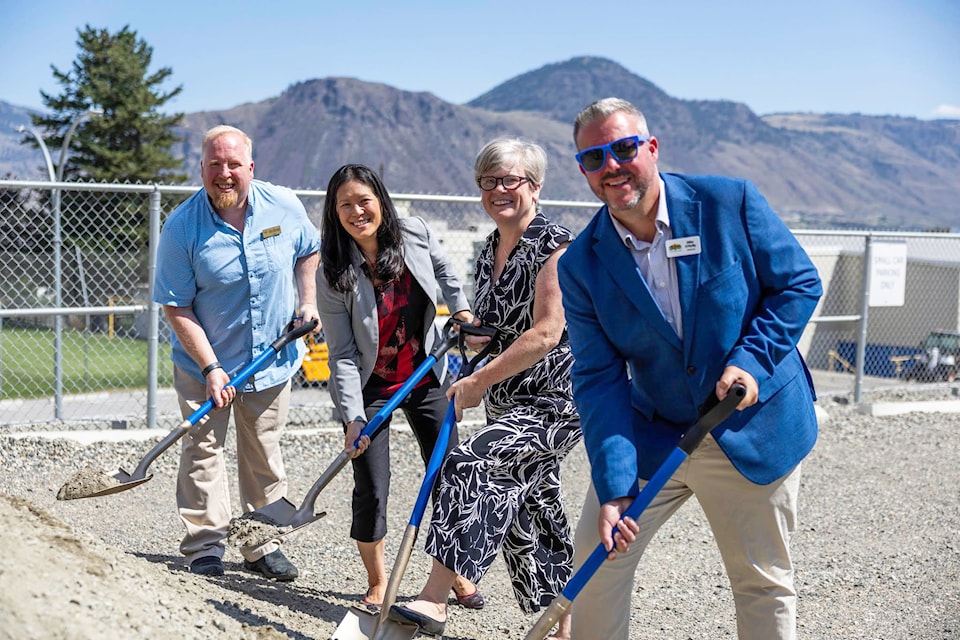Clearwater Mayor Merlin Blackwell described the ground breaking for the new BC Cancer Centre in Kamloops as good news for the region.
The cancer centre "will ease a lot of people’s concerns about cancer treatment," he said, adding he has received “really nice feedback” from people seeing the progress and “where we are at in this process."
Blackwell joined Minister of Health Josie Osborne, Minister of Infrastructure Bowinn Ma and Chair of the Thompson Nicola Regional Hospital, Mike O'Reilly to put shovels in the ground to mark the start of the $386-million cancer care ahead of construction on Thursday, June 24.
“There were a lot of people there including the Thompson Regional Hospital District (TRHD) who have approved a tax increase to cover a $45 million contribution by taxpayers to the project," Blackwell said. "This money is put into the project by our regional district which includes the area around Lillooet and the West Shuswap. It's a little bit larger than our regular regional district so that is a fairly significant contribution overall.”
The goal is to have it completed by the fall of 2028 and then operational late 2028 – early 2029 based on the ability to staff and other needs.
Blackwell said the new building will house radiation treatment rooms and therapy planning including a CT simulator, a diagnostic MRI, an outpatient oncology ambulatory care unit (including exam and consult rooms), an interfaith sacred space, patient arrival and check-in, staff workspaces and a parkade.
“The majority of services will be in the new building with the exception of chemo and pharmaceutical stuff related to chemo which will still remain on a floor of the hospital in the old tower just because there isn’t enough space in the new building footprint."
Chemo services have already been taking place inside Royal Inland so the Cancer Centre will add even more services in the new building enabling patients to get treatment closer to home, he added.
There are currently other places outside of the hospital offering services such as mammography and lab work in locations off site from Royal Inland.
When asked about the issue of the new centre not including a PET/CT scanner, Blackwell said some of the reasons that there wasn’t a PET scanner put into this building is the geography of the building and the design.
"I look at it from two ways. One, we’re going to have a cancer centre that theoretically is due to be open by the end of 2028 – 29 without there being a delay to redesign which could move that to 2030 or 2031. We are still advocating for the PET/CT scanner, we are definitely not giving up on the need for that. Even if that will be in another building or location in Kamloops, it’s still better than having to travel to Kelowna or Vancouver.”
Blackwell is a cancer survivor and Cancer Won’t Wait advocate, with firsthand experience in the additional stress of having to travel far from home which adds to a person’s personal cancer battle.
“Coming from the North Thompson Valley, you are looking at a minimum 12-hour day to travel to Kelowna, even if you time your appointment perfectly for any sort of treatment there for just a basic appointment. Realistically, it can be a 16-hour day if you can even accomplish it in the same day. Especially arranging transportation and support along with that. With two hours of driving time for example from Clearwater to Kamloops and back is a dramatic improvement over 12 to 16 hours. Reducing travel time and the relief from extra stress and when you bring all of that treatment much closer to home it's a massive change,” he said.
When asked how he feels about the announcement on July 24 advising expectant parents and families of potential changes to maternity services at Royal Inland which serves much of the Interior, he replied, it is definitely not a great situation.
"It shows how fragile the whole system is in some ways when it comes to it. We’re recruiting and retaining the people that we need to keep these systems functioning, especially things like maternity, which has a very specialized group of people that do that work. We need to do our best to give these people a good quality of life to keep them interested in doing these jobs.
"We need to focus on recruitment, retention and just to back-fill so that the existing doctors, nurses and specialists that do maternity care have a break. We need to attract young people to healthcare not scare them away and also offer them a good quality of life and work environment – that’s what we really have to work on.”



